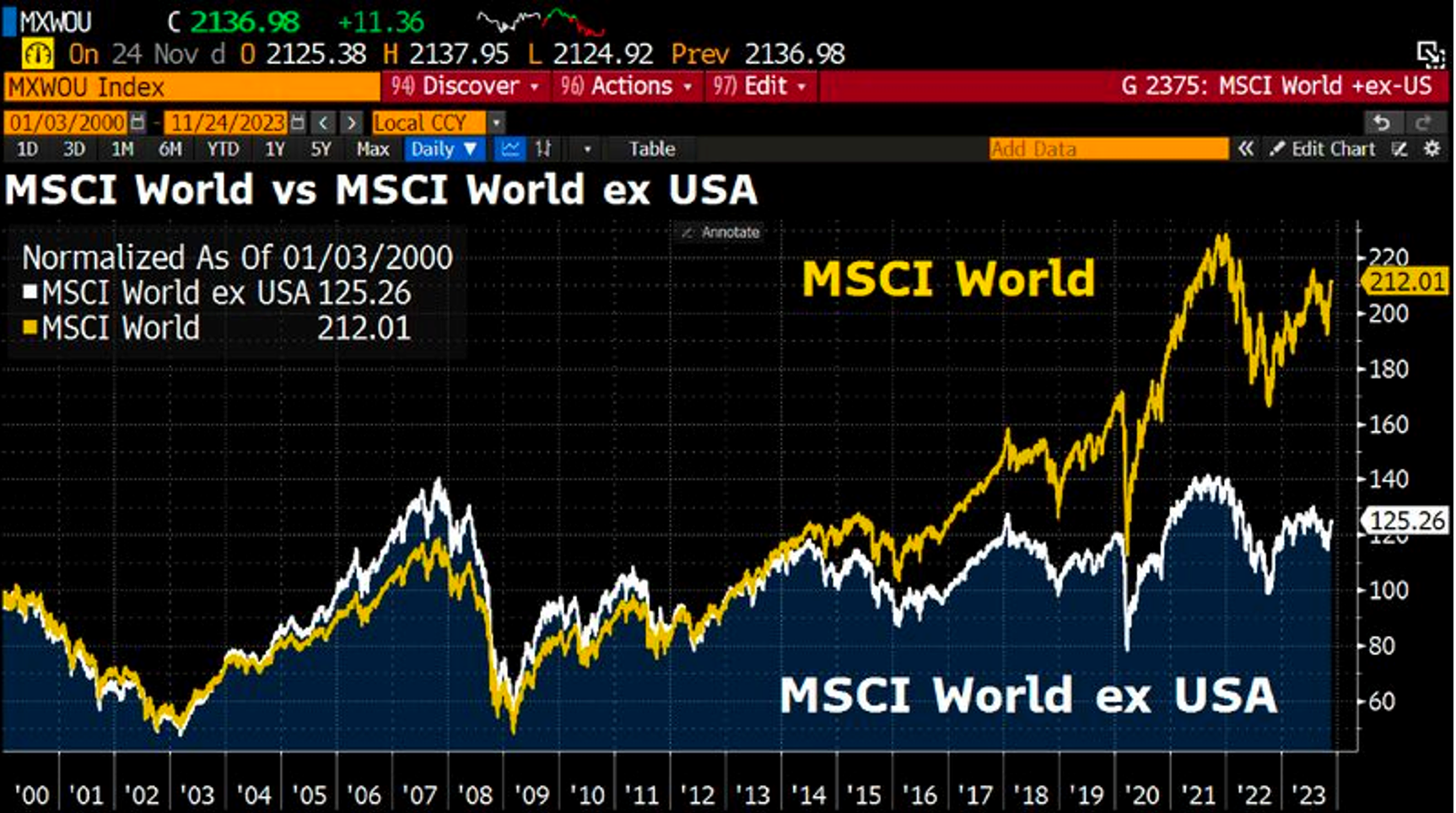The popular MSCI World has booked nearly twice the return of the MSCI World ex USA index since the year 2000, underlining the dominance the largest equity market has established over other companies around the globe.
Between the turn of the millennium and 24 November this year, the parent index boasted a convincing eighty-seven percentage point lead over its ex-US counterpart with gains of 212% and 125%, respectively.
The two indices spent most of the first 13 years on either a level footing or the ex-US benchmark leading – at one point gaining a twenty-percentage point advantage in H2 2007 as emerging market equities outperformed developed markets in the run-up to the Global Financial Crisis.
However, the historical leadership of US equities re-established itself from 2013, following the establishment of the post-GFC monetary policy paradigm of low interest rates.
Chart 1: MSCI World index vs MSCI World ex USA index

Source: Bloomberg, Syz
Whereas higher rates force unprofitable or debt-laden companies to discount future cash flows, lower rates mean borrowing costs are lower and future expected profits are more attractive.
This laid the foundations for a decade-long broad tech rally that pre ‘dot-com’ bubble investors had envisaged some 20 years prior.
A key turning point was August 2012, which saw Apple overtake Exxon Mobil as the largest constituent of the S&P 500 – a changing of the guard from value to growth equities.
Much to the delight of US-heavy passive investors, the next decade of large cap equity returns was dominated by the narrow leadership of US tech and communications names, characterised as the FAANGs or later iterations.
Demonstrating this, the MSCI World booked 8.1% annualised returns over the 10 years to 31 October, versus 3.6% for the MSCI World ex USA index, according to MSCI data, representing a seventy-six-percentage point cost for leaving US equity on the table over the past decade.
Time to kick the US addiction?
Speaking on the difficulty of forgoing the US equity opportunity, Richard Champion, deputy CIO, UK at Canaccord Genuity Wealth Management, told ETF Stream the US appeals not just because of growth heavy large caps but the structural qualities of the market.
“The US remains the best market in the world,” Champion continued. “They have companies that are more profitable, they have a better legal and capitalistic framework in which to operate so they deserve a premium.”
However, over-concentration in US equity remains a hot topic, with the in-vogue ‘magnificent seven’ mega caps comprising 100% of the gains made by the S&P 500 in H1.
Underlining the dominance of this narrow group, these companies claim the top seven allocations and 18.9% of the total weighting of the parent MSCI World benchmark – an index covering 1,511 stocks.
The top 10 positions of the ex-US benchmark, meanwhile, contain nine European equities and Toyota, with a combined weighting of 13.6%.
These dynamics go some way to explaining why investors such as Champion are looking beyond market cap-weighted exposure to US equities.
“In the US, we have been looking at the equal-weighted ETF as a way of getting a bit more breadth without taking too much specific risk,” Champion added.
Concentration among US large caps also highlights the appeal of segmenting US exposure from the rest of a global equity portfolio from a portfolio construction perspective, much as emerging market investors might look to root out Chinese equity dominance within the parent MSCI Emerging Markets index.
Saurabh Katiyar, executive director, head of index solutions research, EMEA at MSCI, said at a recent ETF Stream roundtable: “We have been discussing EM ex-China but is worth noting this is not just from a risk perspective, it is also about portfolio construction and we see a similar thing with clients wanting to separate their US equity exposure with the MSCI World ex USA index.”






